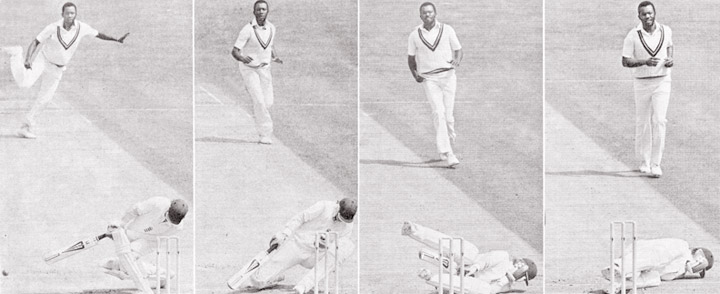Good batsmen don't fear bouncers
By A.C. De Silva
|

A nightmarish start for new cap Andy Lloyd......(2nd from
left)...... Hit on the right ‘temple’ by a Marshall bouncer,
the opener doubles up.... and rolls over while Marshall
seems upset over the implications.... The implications: A
trip to hospital and a three-week forced break from cricket
for Lloyd. |
How do batsmen get hit by genuine fast bowling? The batsmen through
lack of technique get injured. This is the view of one time Somerset,
Yorkshire and England captain Brian Close.
England's Andy Lloyd playing in the first Test against the West
Indies at Edgbaston has raised the issue of short-pitched "intimidatory"
bowling.
Lack of technique
This type of bowling has also sparked off the number of bouncers per
over to be limited to one or two.
As the experienced batsmen are concerned, batsman get hit against
genuine fast bowling simply through lack of technique. And the answer to
the problem lies with no one but the batsmen themselves.
England's Lloyd was hit by a short pitched fast delivery by Malcolm
Marshall and ended up in hospital with injuries.
He was hit because, in trying to duck away from a ball he got himself
into a position he could not get out of.
Players of the past knew how to deal with bouncers. They stuck to the
timeless principle that cricket is a sideways game and that instead of
ducking under a ball, the way to avoid being hit is to keep still and at
the last moment sway to one side. All it needs is a flick of the head
and if you keep your eye fixed firmly on the ball, the only time you
will suffer injury is by getting a top edge trying to play an attacking
stroke. When that happens no technique in the world will enable you to
take evasive action.
Helmet a hindrance
It is taken for granted that helmet and other forms of protective
gear has hindered rather than helped.
These space age additions were brought in as a result of fear and
have given batsmen a false sense of security.
They think that because of their suits of armour they can get away
with deficiencies in technique.
Looking specially at Test cricket, what worries the organisers,
speaking specially of the Edgbaston track was very easy paced. Several
of the England batsmen were suspect against the quick stuff and the
pitches for the remaining matches in the years to come were likely to be
far from docile.
The drawback
There appears to be three main batting flaws that prevailed in the
English game. Some of the English batsmen do not hold their bats
correctly, don't know how to use their feet and have the wrong mental
attitude against fast bowling.
What is worst they don't appear to care enough to work at putting
things right.
In England each county generally has a cricket coach of their own who
has the responsibility of bringing the younger players through to first
class cricket in the framework of the Second Eleven championship.
Yet once players reach county standard and establish themselves in
the first team, how many bother practise to improve their technique?
The cause of issue at stake
One of the main problems is that there is too much of limited-over
cricket. Young players are thrown into a situation where their side
needs to score runs quickly. They develop bad habits by trying to play
attacking shots to good deliveries which, in normal circumstances, they
would play in a correct, defensive manner.
These habits have stuck and, unless people take responsibility to
halt the trend, things will only get worse.
The time has come for people who care about the development of the
younger set of cricketers to come forward and help them to become better
players, without waiting to be asked.
There are plenty of qualified people in the game whose experience and
advice would help players to get the best out of themselves.
Brian close says that when he was captain of Somerset he got into hot
water because some felt that he was too hard on the players. When asked
what they wanted.
Players who can play cricket or players who turn up because they have
nothing better to do?
Why limit them?
Good batsmen, with the correct technique are not intimidated by
bouncers. A short-pitched ball with no stroke should not be squandered
and bowlers would soon stop sending them down if they became a waste of
time.
Talk of limiting the numbers of bouncers a bowler is allowed to bowl
in an over is somewhat of a nonsensical move.
Close says that when he was called back to face the West Indies in
1976, the last thing he wanted was the bowler being handicapped by
restriction.
Mike Holding, Andy Roberts and Wayne Daniel at Old Trafford - it was
a real gloves-off old fashioned scrap!
And if Malcolm Marshall is limited to bowl only two bouncers in an
over, he may bowl the first two deliveries short and fast. The batsman
then knows he is not going to get another in the over. He relaxes and
fancies his chances of getting on to the front foot.
Marshall accidentally slip one short, the batsman, unprepared is in
no position to defend himself and is caught fending it off.
The umpire is not going to call a batsman back to the wicket because
of an accidental third bouncer!
The cricket authorities would do well to concern themselves more with
prevention than a half-baked cure.
|

